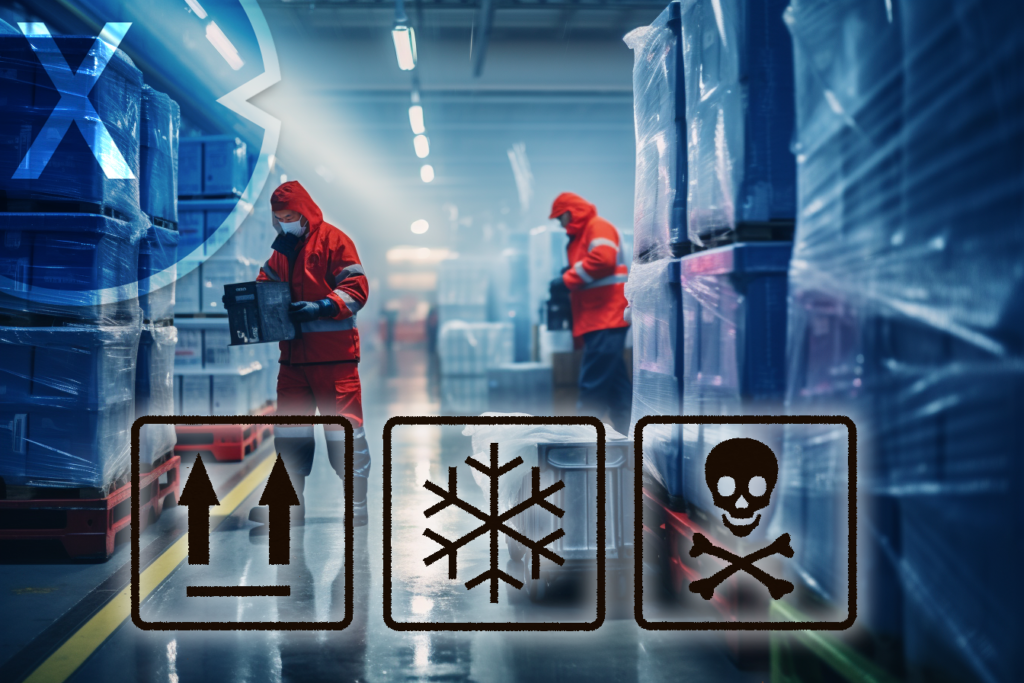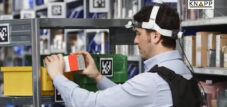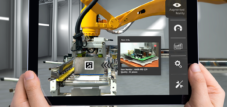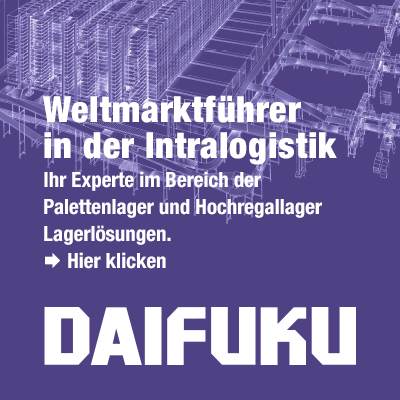Optimal for frozen and fresh logistics picking: Pick by voice picking solution – ergonomic and cost-efficient
Language selection 📢
Published on: March 6, 2024 / Update from: March 6, 2024 - Author: Konrad Wolfenstein
❄️📦 Efficient picking: Why pick-by-voice is transforming frozen logistics
🚚 The logistics industry is constantly facing new challenges, especially in the area of frozen and fresh logistics. The demand for fast, error-free and efficient supply chains is greater than ever. A key element in overcoming these challenges is optimizing the picking process. In this context, the pick-by-voice order picking solution is proving to be groundbreaking. This technology not only offers ergonomic advantages, but is also convincing in terms of cost efficiency. The following takes a detailed look at how pick-by-voice technology works, what advantages it offers and why it is particularly suitable for frozen and fresh food logistics.
🔊🗣️ Voice-controlled picking: What is Pick by Voice?
Pick by Voice is a picking system in which communication between the warehouse employee and the merchandise management system takes place using voice. The employees wear a headset with a microphone and receive audio signals or voice instructions about which items they should remove, where and in what quantities. Confirmation of the removed articles is also done verbally. This interaction allows employees to have their hands and eyes free for the actual task, improving ergonomic working conditions and significantly reducing error rates.
👐 Ergonomic Advancement: Ergonomic advantages
The ergonomic advantages of pick-by-voice technology should not be underestimated. By having their hands free, employees can move better and more safely, especially in a demanding work environment such as the freezer area, where work needs to be done quickly but extra caution is also required. Additionally, avoiding visual inspection of lists or handheld scanners reduces eye strain and reduces the risk of headaches or eye fatigue. These aspects contribute significantly to improving working conditions and increasing employee satisfaction.
💰 Cost-benefit analysis: cost effectiveness
The cost effectiveness of pick-by-voice technology arises from several factors. First, reducing picking errors results in significant savings by eliminating the costs of returns and order re-picking. Furthermore, the higher speed at which employees can work enables better utilization of existing resources. Last but not least, increased employee satisfaction leads to lower sickness rates and lower fluctuation, which reduces the costs of recruiting and training new employees.
❄️ Requirements in cold zones: Application in frozen and fresh logistics
In frozen food and fresh produce logistics, the requirements for picking are particularly high. Products not only have to be picked and processed quickly, but also in compliance with strict temperature specifications. Pick-by-Voice technology allows both requirements to be met. By using voice-controlled systems, employees can work more efficiently while maintaining the necessary safety and hygiene standards. The hands-free, eyes-free operation is particularly advantageous here as it makes it easier to wear protective clothing and work in cold environments.
🔮 Looking into the future: Future developments
The further development of pick-by-voice technology is constantly progressing. Future improvements could include even more precise speech recognition, the integration of artificial intelligence to optimize picking routes in real time, and improved adaptability to different languages and dialects. In addition, advances in hardware, such as lighter and longer-lasting batteries or more comfortable headsets, could further increase usability.
🚀 Strategic innovation: pick-by-voice order picking solution
The pick-by-voice picking solution offers significant advantages for the logistics industry, especially in the demanding area of frozen and fresh logistics. The technology not only improves working conditions for employees, but also increases the efficiency and cost-effectiveness of the picking processes. With further technological developments on the horizon, the role of pick-by-voice technology in logistics is expected to continue to grow, enabling companies to meet increasing demands for speed, accuracy and efficiency in the supply chain.
📣 Similar topics
- 🗣️ Voice-controlled picking: efficiency and ergonomics in logistics
- 🔮 The future of picking: Pick by Voice is revolutionizing the logistics industry
- 💼 Ergonomics and efficiency: Pick-by-voice technology in focus
- 📦 Voice-controlled logistics: The advantages of pick by voice
- ⚙️ Efficient and error-free: The role of pick-by-voice in logistics
- 🚀 On the rise: pick-by-voice technology in frozen and fresh logistics
- 🛠️ Improved working conditions through pick-by-voice picking
- 💰 Cost savings and increased efficiency: The advantages of Pick by Voice
- 🔒 Future security in logistics: Pick by Voice as a key technology
- 💡 Innovation in picking: Pick by Voice as a pioneer
#️⃣ Hashtags: #Logistics #Voice-controlled #Efficiency #Ergonomics #PickbyVoice
📌 Other suitable topics: commissioning solutions
🧊 Technology leader Japan in refrigerated logistics – better working conditions optimize distribution processes

Refrigerated logistics/fresh logistics: Cold storage with automated material flow optimizes distribution processes - Image: Xpert.Digital
Asian countries such as Japan in particular are considered pioneers here. Tokyo, one of the largest cities in the world with over 38 million inhabitants, impressively shows how high population density and quality of life can be combined with the help of innovative urban and infrastructure planning. The expansion of efficient transport and supply systems has been the focus here for decades.
More about it here:
🌎❄️ Icy chains of supply: The world of refrigerated logistics
Refrigerated logistics or cold logistics is an essential area of modern delivery and supply chains that deals with the planning, implementation and control of the transport and storage of temperature-dependent goods. This includes a wide range of products, from food to pharmaceuticals to chemical substances, whose quality, safety and effectiveness depend on compliance with strict temperature guidelines.
The importance of efficient refrigerated logistics cannot be overestimated, especially since it directly affects food quality, the effectiveness of medicines and therefore the health and safety of the population. The particular challenges in this sector arise not only from the physical requirements of cooling, but also from complex regulatory requirements and the desire to make logistics processes sustainable and energy efficient.
🧊 Temperature-controlled storage and transport
Different goods require different temperatures - frozen products are usually stored at temperatures between minus 18°C and minus 23°C, while temperatures between 3°C and 8°C are optimal for fresh products. Maintaining these conditions across entire supply chains, particularly during long-distance transport and transshipment, requires not only specialized equipment such as refrigerated vehicles and cold storage, but also careful planning and monitoring.
⚡ Rising energy costs and efficiency
One of the largest cost factors in refrigerated logistics is the energy costs of maintaining the required temperatures. As energy prices rise, the pressure on logistics companies to optimize their processes and increase energy efficiency is growing. Innovative technologies and practices, such as using energy-efficient refrigeration equipment, optimizing route planning, or implementing insulation techniques in warehouses and transportation, can help reduce energy consumption and therefore reduce costs.
📜 Regulatory requirements and compliance
Compliance with complex regulatory requirements is another critical aspect of refrigerated logistics. Systems such as HACCP (Hazard Analysis and Critical Control Points) and GDP (Good Distribution Practice), as well as standards such as IFS Logistics and the ATP Convention, ensure that companies implement effective control mechanisms to consistently ensure the integrity of temperature-controlled goods. These regulations aim to guarantee the safety and quality of products throughout the supply chain, but require companies to maintain a high level of organization and supervision.
Regulatory frameworks vary depending on the country or region, but usually follow similar principles. The most important regulations include:
HACCP (Hazard Analysis and Critical Control Points)
A preventative management system to ensure food safety.
GDP (Good Distribution Practice)
Guidelines for the proper distribution of medicines.
IFS Logistics
A standard for checking the quality and safety of processes along the entire supply chain.
ATP Convention (Convention on the International Transport of Perishable Foodstuffs)
International agreement that specifies requirements for the means of transporting perishable foodstuffs.
➡️ These regulations require companies to implement effective controls and procedures to ensure the integrity of temperature-controlled goods at all times.
💡 Technological innovations and digitalization
The application of technology has opened up new opportunities in refrigerated logistics to increase efficiency and ensure regulatory compliance. Real-time temperature monitoring, automated temperature control systems, digital documentation and blockchain technologies enable companies to precisely manage temperatures, improve product traceability and simplify documentation processes. In addition, technological innovations such as IoT-based sensors and AI-supported analyzes make a decisive contribution to optimizing refrigerated logistics processes.
🌱 Sustainability and environmental responsibility
Increasing awareness of environmental issues presents refrigerated logistics companies with the challenge of reducing their carbon footprint and adopting more sustainable practices. Investing in green technologies, reducing dependence on fossil fuels and optimizing logistics routes are essential steps to reduce environmental impact. Environmental management systems that monitor and control energy consumption not only contribute to compliance with legal requirements, but also improve the public image of companies.
Refrigerated logistics is constantly changing, driven by technological advances, changing market conditions and new legal requirements. Companies operating in this area are faced with the task of continually adapting and optimizing their processes in order to operate in an economically efficient and ecologically sustainable manner. This not only increases the value for your own company, but also makes an important contribution to protecting the health and safety of consumers and preserving the environment.
❄️ Challenges and solutions
📜 Compliance with regulatory requirements presents refrigerated logistics companies with various challenges. The most important include:
🌡️ Temperature management
Maintaining consistent temperatures throughout the logistics process is crucial. Innovative technologies such as real-time temperature monitoring and automated temperature control systems can help here.
📄 Documentation and traceability
Complete documentation and the ability to trace goods are essential to ensure compliance and to be able to act quickly in the event of problems. Digital solutions and blockchain technology offer new opportunities for efficient data collection and storage.
👩🏫 Training of staff
Well-trained employees are a central factor in compliance with regulatory requirements. Regular training and development activities ensure that staff are familiar with current requirements and best practices.
🌍 Sustainability and energy efficiency
As environmental awareness grows, companies are under pressure to reduce their carbon footprint. Investments in energy-efficient cooling technologies and the optimization of logistics processes help reduce the environmental impact.
➡️ Numerous companies have proven that through innovative thinking and strategic adjustments, compliance with regulatory requirements can not only be possible, but also economically advantageous. An example of this is the introduction of pick-by-voice picking solutions, GPS and IoT-based monitoring systems, which enable seamless monitoring of the cold chain. This means that temperature deviations can be detected in real time and immediate corrective measures can be taken, which not only helps ensure product quality but also increases efficiency and saves costs.
➡️ Another example is the implementation of environmental management systems that optimize energy consumption and reduce dependence on fossil fuels. Such systems not only support compliance with legal requirements, but also improve the company's public image.
📣 Similar topics
- 🌡️ Efficient refrigerated logistics: quality of life and safety through temperature control
- 🔋 Cost management in refrigerated logistics: Energy efficiency as the key to cost reduction
- ⚖️ Strictly regulated cold chains: compliance in cold logistics
- 💡 Digital Revolution: Technological innovations in refrigerated logistics
- 🌿 Green refrigerated logistics: Sustainability and environmental awareness in focus
- ❄️ Challenges of frozen logistics: From sub-zero temperature management to quality preservation
- 🔄 Refrigerated logistics in transition: Adaptation to new market conditions and legal requirements
- 💊 Temperature-critical goods: From pharmaceutical to food logistics
- 📊 IoT and AI in refrigerated logistics: optimization through intelligent technologies
- 🌎 Global cold chains: Efficiency and compliance in international supply networks
#️⃣ Hashtags: #Refrigerated Logistics #Energy Efficiency #Compliance #TechnologicalInnovation #Sustainability
Xpert partner in warehouse planning and construction
🎧📦 Efficient warehouse work: How pick-by-voice increases efficiency and safety in the warehouse
🗣️ Pick-by-Voice is a picking technology used in warehouse and distribution logistics. It allows employees to communicate with the warehouse management system through verbal instructions via a headset to make goods removal and storage more efficient. This technology uses voice recognition software that converts the warehouse worker's spoken instructions into data that the warehouse management system can use, and vice versa.
Here are some key elements and benefits of pick by voice systems:
🔊 How it works
1. Instruction reception
The warehouse employee wears a headset with a microphone and uses this to receive audio-visual picking instructions from the warehouse management system.
2. Confirmation
The employee carries out the instruction (e.g. removing a certain number of products from a certain shelf) and verbally confirms the action carried out via the microphone.
3. Further instructions
After confirmation, the system sends the next task.
💡 Benefits
Increased efficiency
Through direct communication with the system, routes can be optimized and picking processes can be completed more quickly.
Hands and eyes free
Employees have both hands free to handle the goods and do not have to constantly look at a display, making work safer and more comfortable.
Error reduction
Voice instructions reduce the risk of product selection errors as the employee receives direct feedback on the picking process. In addition, voice confirmation ensures that the correct goods are picked in the correct quantity.
Quick training
New or temporary employees can be trained quickly, which is particularly advantageous during busy times.
flexibility
Pick-by-Voice can be easily configured for different languages, making it ideal for multinational deployments and employees from different backgrounds.
🚀 Areas of application
Pick-by-voice is used in many areas of warehousing and logistics, particularly those where speed and accuracy are critical, such as retail, food and pharmaceutical logistics. By implementing this technology, companies can optimize their warehouse operations, increase productivity and reduce errors.
📣 Similar topics
- 🔊 Voice-controlled technologies in warehouse logistics
- 📈 Increased efficiency through pick-by-voice systems
- 🚀 New ways in picking technology: Pick-by-Voice explained
- ✅ How pick-by-voice systems work and advantages
- 🛡️ Safety and comfort: The advantages of freedom of hands and eyes in logistics
- ❌ Error reduction through voice instructions: Pick-by-voice in detail
- 🏁 Quick training and flexibility: The advantages of pick-by-voice
- 📍 Pick-by-Voice: Areas of application and areas of application
- 🌍 Multinational logistics: The flexibility of pick-by-voice systems
- ⚙️ Optimization of warehouse operations: pick-by-voice in practice
#️⃣ Hashtags: #language technology #warehouse logistics #increasing efficiency #picking technology #logistics innovation

Xpert.Plus warehouse optimization - high-bay warehouses such as pallet warehouses consulting and planning
We are there for you - advice - planning - implementation - project management
☑️ Smart City & Factory: Industry expert for energetic 5G buildings and halls as well as advice and installation of solar systems
☑️ Xpert.Plus - logistics consulting and logistics optimization
☑️ Industry expert, here with his own Xpert.Digital Industry Hub with over 2,500 specialist articles
I would be happy to serve as your personal advisor.
You can contact me by filling out the contact form below or simply call me on +49 89 89 674 804 (Munich) .
I'm looking forward to our joint project.
Xpert.Digital - Konrad Wolfenstein
Xpert.Digital is a hub for industry with a focus on digitalization, mechanical engineering, logistics/intralogistics and photovoltaics.
With our 360° business development solution, we support well-known companies from new business to after sales.
Market intelligence, smarketing, marketing automation, content development, PR, mail campaigns, personalized social media and lead nurturing are part of our digital tools.
You can find out more at: www.xpert.digital - www.xpert.solar - www.xpert.plus
Industrial & B2B Business Metaverse: Reduce costs with XR technology for photorealistic product images (XR 3D rendering machine)
XR technology offers a superior solution for creating photorealistic images and allows companies to free themselves from the expensive fees of external media agencies. It is common knowledge that media agencies charge high costs to create such images as it requires expertise, special software and collaboration with various experts.
More about it here:

































